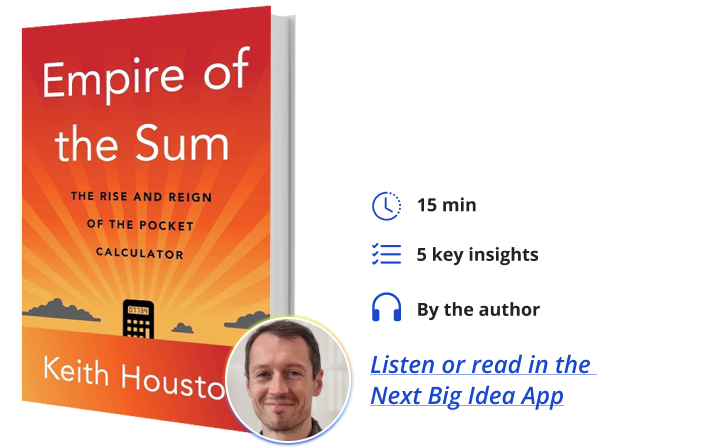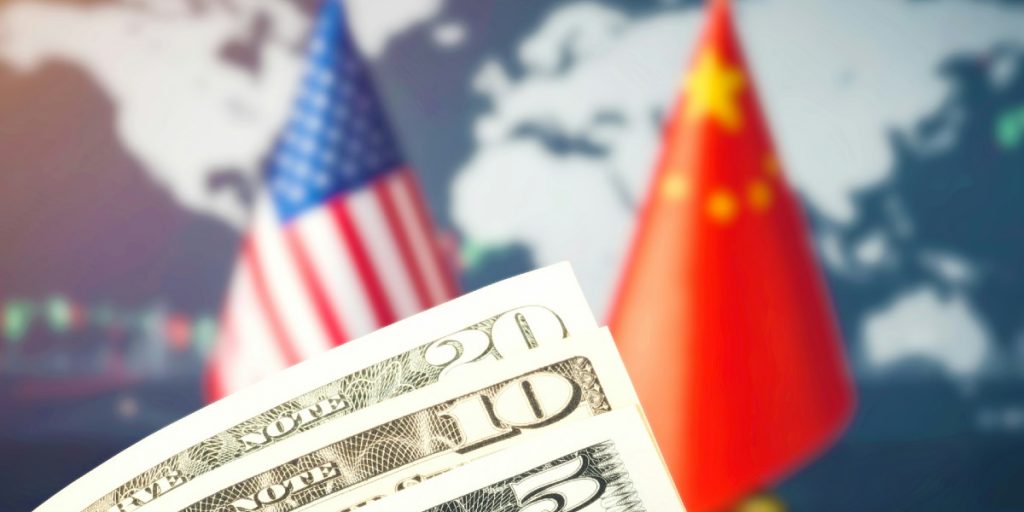Keith Houston is a writer whose work has appeared in the New York Times, the Wall Street Journal, the Financial Times, Mental Floss, and BBC Culture, among others.
Below, Keith shares five key insights from his new book, Empire of the Sum: The Rise and Reign of the Pocket Calculator. Listen to the audio version—read by Keith himself—in the Next Big Idea App.

1. There is nothing new under the sun.
In writing each of my books, there has come a point where I realize that I’m going to have to talk about ancient Mesopotamian culture. Or ancient Egyptian culture. Or ancient Greece, or Rome, or China, or even all of the above.
In this book, that time came when I realized that the first written numbers, in Sumerian cuneiform, came from clay tokens that represented quantities like a bushel of barley or a day of labor. In turn, those tokens may just have influenced the development of the earliest abacuses, or counting boards, where tokens or pebbles were placed on a grid to represent numbers. Right away, we’re back at the dawn of literate culture.
Then, in Greece, we see the earliest archaeological discoveries of counting boards—great marble slabs carved with lines on which to place counting tokens. Rome then gives us the earliest known portable abacuses, in the form of little slotted brass plates with buttons that can slide up and down. Then, over in China —the birthplace of paper and printing—abacuses using strings or wires are described in a book that dates to around the same time as Rome’s pocket abacuses.
In other words, writing, counting, and calculation are all bound up in the same histories, peoples, and places that crop up over and over again. This shouldn’t be surprising. We’re all human, after all, and humans like to acquire information, record it, and manipulate it. That’s exactly what writing and math are for. The most important inventions are the ones that relate to the human condition, and they crop up over and over again.
2. War focuses the mind.
The first pocket calculator was called the Curta. It was about the size of a Coke can, or a little smaller, with a crank on top and numeric sliders on the side. Although it looked like a coffee grinder, it in fact was the very first digital pocket calculator. It was mechanical but added and subtracted with absolute precision. It made quite a splash. Partly this was because it made calculators portable in a way that they had never been before, but also because its designer had created it while interned in one of the Nazi’s most notorious concentration camps.
“Although it looked like a coffee grinder, it in fact was the very first digital pocket calculator.”
At its heart, the Curta was not a new machine. Instead, it reused the principles behind an earlier, larger mechanical calculator called the arithmometer. The arithmometer, too, had been designed by a man with first-hand experience of war. In this case, the creator was Charles Xavier Thomas, the quartermaster of a French army stationed in Spain in the nineteenth century.
Thus, the same thing happens over and over again. The Casio 14-A, the first calculator with no rotating gears or cams, was modeled on computers designed before and during World War 2. The first solid-state calculator, the Sumlock Anita, was designed by a man who had worked on a variety of vacuum tube computers—also during the Second World War. The Canon Pocketronic, which was arguably the first ever electronic pocket calculator, was largely a vehicle for Texas Instruments to sell microchips when their contracts with the US military had dried up.
3. If you don’t have a market, create one.
The Canon Pocketronic, actually, was the mass-produced version of a prototype calculator designed by Texas Instruments. It was called the Cal Tech, and it was TI’s solution to a problem: how to sell more microchips. A TI engineer called Jack Kilby had invented the first practical semiconductor microchip, in which multiple electronic components were placed on a single piece of silicon or germanium, and TI had made a lot of money selling them to the U.S. military.
But TI wanted to sell more, and so the company repeated a trick it had pulled off once already: it invented a new product to sell electronic components. TI’s president, Pat Heggarty, had previously concocted a plan to sell more transistors inside transistor radios, and now he wanted to sell more microchips inside pocket calculators.
Calling the Cal Tech a “pocket calculator” is a bit of a stretch though, as the pocket would have to be unusually roomy to hold one of these units inside it. But the plan worked all the same. Even though he Pocketronic was delayed to the point where other, better calculators appeared before it was released, TI went on to become one of the biggest calculator companies in the world—and it still is today.
4. Sometimes, perfection is all you need.
Hewlett-Packard were, and are, a big American technology company. They got started, as all good tech companies do, in a garage: Bill Hewlett and Dave Packard started out making electronic gadgets in Palo Alto, California. By the 1960s, Dave Packard took a leave of absence to work as Deputy Secretary of Defense and Bill Hewlett wanted to branch out from what the company called “electronic instruments”—oscilloscopes, signal generators, and so on—and into electronic calculators.
“The HP-35 was the first calculator to really showcase what was possible.”
HP released a bulky desktop calculator first, called the HP9100A, but it was their follow-up, the actually pocket-sized HP-35, that made the real splash. The HP-35 didn’t do anything that other calculators didn’t already do. It had arithmetic and scientific functions, good design, and a pocketable form factor. But for the first time, it had all of these things at once. Just like the iPhone took ideas from other smartphones and pocket computers and put them into a single sleek package, the HP-35 was the first calculator to really showcase what was possible.
And the HP-35 was a runaway success. Students sold their cars to buy them. NASA engineers had to lock them away to stop them from being stolen. The HP-35 was the first must-have calculator, and possibly the first must-have consumer electronic device of any kind.
5. Form is temporary, function is permanent.
The home computer pushed the calculator out of most workplaces. It’s very rare today that you’ll see a calculator in the wild. Schoolchildren still use them for exams, of course, and you sometimes see them on corner shop counters or a bank teller’s desk, but in the wider world, the pocket calculator has effectively become extinct.
Or has it? Just about every computer, tablet, and smartphone in the world has a calculator app. You can even type a mathematical expression into Google or Bing and get an immediate answer, just like a calculator. The pocket calculator may be dead, but the idea of the pocket calculator is too useful to ever die off. The calculator is going to be around for a long time to come.
To listen to the audio version read by author Keith Houston, download the Next Big Idea App today:






























